AMD’s Kaveri: Pre-Launch Information
by Ian Cutress on January 6, 2014 8:00 PM EST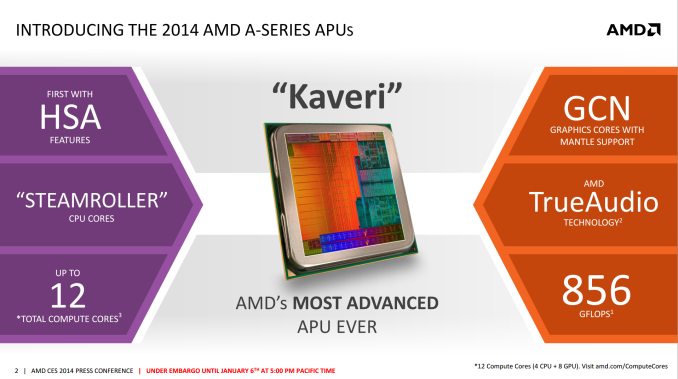
On the back of AMD’s Tech Day at CES 2014, all of which was under NDA until the launch of Kaveri, AMD have supplied us with some information that we can talk about today. For those not following the AMD roadmap, Kaveri is the natural progression of the AMD A-Series APU line, from Llano, Trinity to Richland and now Kaveri. At the heart of the AMD APU design is the combination of CPU cores (‘Bulldozer’, ‘Steamroller’) and a large dollop of GPU cores for on-chip graphics prowess.
Kaveri is that next iteration in line which uses an updated FM2+ socket from Richland and the architecture is updated for Q1 2014. AMD are attacking with Kaveri on four fronts:
Redesigned Compute Cores* (Compute = CPU + GPU)
Kaveri uses an enhanced version of the Richland CPU core, codename Steamroller. As with every new CPU generation or architecture update, the main goal is better performance and lower power – preferably both. AMD is quoting a 20% better x86 IPC with Kaveri compared to Richland when put clock to clock. For the purposes of this information release, we were provided with several AMD benchmarking results to share:
These results border pretty much on the synthetic – AMD did not give any real world examples today but numbers will come through in time. AMD is set to release two CPUs on January 14th (date provided in our pre-release slide deck), namely the A10-7700K and the A10-7850K. Some of the specifications were also provided:
| AMD APUs | ||||
|
Richland A8-6600K |
Richland A10-6800K |
Kaveri A10-7700K |
Kaveri A10-7850K |
|
| Release | June 4 '13 | June 4 '13 | Jan 14th '14 | Jan 14th '14 |
| Frequency | 3900 MHz | 4100 MHz | ? | 3700 MHz |
| Turbo | 4200 MHz | 4400 MHz | ? | ? |
| DRAM | DDR3-1866 | DDR3-2133 | DDR3-2133 | DDR3-2133 |
| Microarhitecture | Piledriver | Piledriver | Steamroller | Steamroller |
| Manufacturing Process | 32nm | 32nm | ? | ? |
| Modules | 2 | 2 | ? | 2 |
| Threads | 4 | 4 | ? | 4 |
| Socket | FM2 | FM2 | FM2+ | FM2+ |
| L1 Cache |
2 x 64 KB I$ 4 x 16 KB D$ |
2 x 64 KB I$ 4 x 16 KB D$ |
? | ? |
| L2 Cache | 2 x 2 MB | 2 x 2 MB | ? | ? |
| Integrated GPU | HD 8570D | HD 8670D | R7 | R7 |
| IGP Cores | 256 | 384 | ? | 512 |
| IGP Architecture | Cayman | Cayman | GCN | GCN |
| IGP Frequency | 844 | 844 | ? | 720 |
| Power | 100W | 100W | ? | 95W |
All the values marked ‘?’ have not been confirmed at this point, although it is interesting to see that the CPU MHz has decreased from Richland. A lot of the APU die goes to that integrated GPU, which as we can see above becomes fully GCN, rather than the Cayman derived Richland APUs. This comes with a core bump as well, seeing 512 GPU cores on the high end module – this equates to 8 CUs on die and what AMD calls ’12 Compute Cores’ overall. These GCN cores are primed and AMD Mantle ready, suggesting that performance gains could be had directly from Mantle enabled titles.
Described in AMD’s own words: ‘A compute core is an HSA-enabled hardware block that is programmable (CPU, GPU or other processing element), capable of running at least one process in its own context and virtual memory space, independently from other cores. A GPU Core is a GCN-based hardware block containing a dedicated scheduler that feeds four 16-wide SIMD vector processors, a scalar processor, local data registers and data share memory, a branch & message processor, 16 texture fetch or load/store units, four texture filter units, and a texture cache. A GPU Core can independently execute work-groups consisting of 64 work items in parallel.’ This suggests that if we were to run asynchronous kernels on the AMD APU, we could technically run twelve on the high end APU, given that each Compute Core is capable of running at least one process in its own context and virtual memory space independent of the others.
The reason why AMD calls them Compute Cores is based on their second of their four pronged attack: hUMA.
HSA, hUMA, and all that jazz
AMD went for the heterogeneous system architecture early on to exploit the fact that many compute intensive tasks can be offloaded to parts of the CPU that are designed to run them faster or at low power. By combining CPU and GPU on a single die, the system should be able to shift work around to complete the process quicker. When this was first envisaged, AMD had two issues: lack of software out in the public domain to take advantage (as is any new computing paradigm) and restrictive OS support. Now that Windows 8 is built to allow HSA to take advantage of this, all that leaves is the programming. However AMD have gone one step further with hUMA, and giving the system access to all the memory, all of the time, from any location:
Now that Kaveri offers a proper HSA stack, and can call upon 12 compute cores to do work, applications that are designed (or have code paths) to take advantage of this should emerge. One such example that AMD are willing to share today is stock calculation using LibreOffice's Calc application – calculating the BETA (return) of 21 fake stocks and plotting 100 points on a graph of each stock. With HSA acceleration on, the system performed the task in 0.12 seconds, compared to 0.99 seconds when turned off.
Prong 3: Gaming Technologies
In a year where new gaming technologies are at the forefront of design, along with gaming power, AMD are tackling the issue on one front with Kaveri. By giving it a GCN graphics backbone, features from the main GPU line can fully integrate (with HSA) into the APU. As we have seen in previous AMD releases and talks, this means several things:
- Mantle
- AMD TrueAudio
- PCIe Gen 3
AMD is wanting to revolutionize the way that games are played and shown with Mantle – it is a small shame that the Mantle release was delayed and that AMD did not provide any numbers to share with us today. The results should find their way online after release however.
Prong 4: Power Optimisations
With Richland we had CPUs in the range of 65W to 100W, and using the architecture in the FX range produced CPUs up to 220W. Techincally we had 45W Richland APUs launch, but to date I have not seen one for sale. However this time around, AMD are focusing a slightly lower power segment – 45W to 95W. Chances are the top end APUs (A10-7850K) will be 95W, suggesting that we have a combination of a 20% IPC improvement, 400 MHz decrease but a 5% TDP decrease for the high end chip. Bundle in some HSA and let’s get this thing on the road.
Release Date
AMD have given us the release date for the APUs: January 14th will see the launch of the A10-7850K and the A10-7700K. Certain system builders should be offering pre-built systems based on these APUs from today as well.



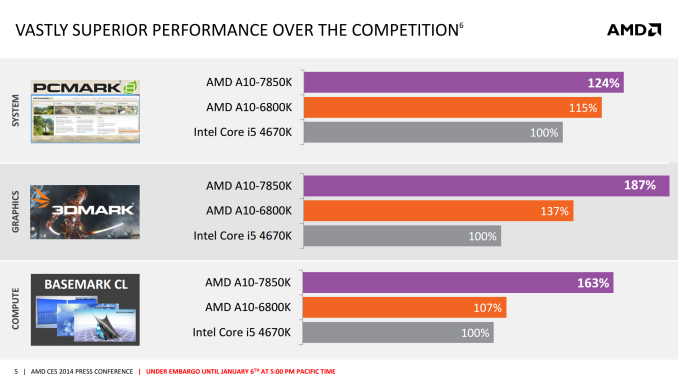
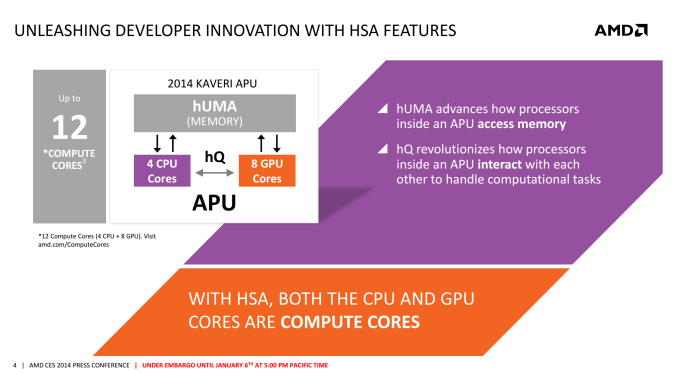
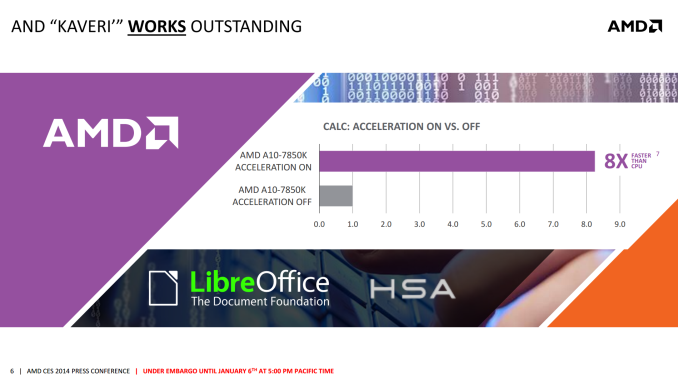
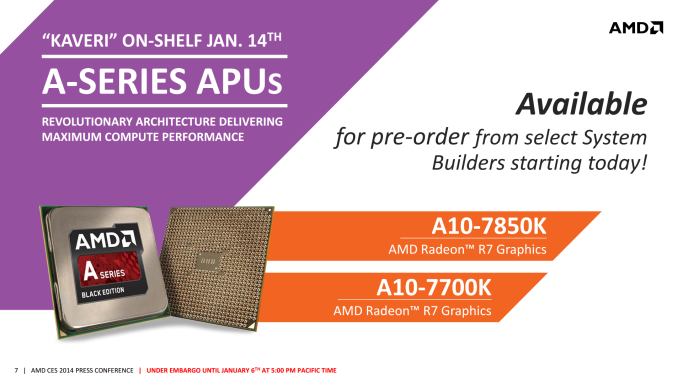
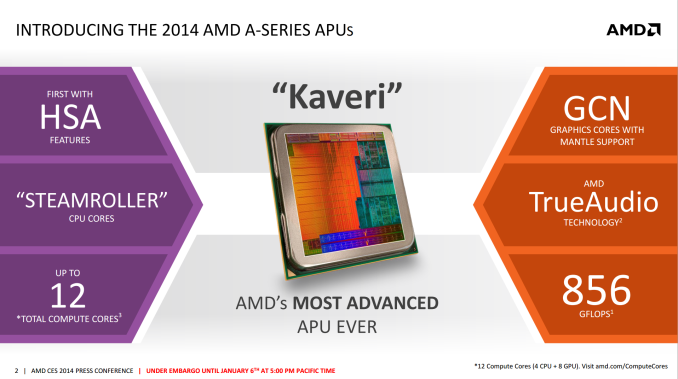








133 Comments
View All Comments
KenLuskin - Sunday, January 12, 2014 - link
Companies like MSFT, Google, Apple, Adobe are ALREADY developing large scale programs.Sure for the small time application putz, you would NOT understand....
BMNify - Monday, January 13, 2014 - link
LOL, it seems you didn't actually read that link so who;s the putz (noun1.a stupid or worthless person.) given it would help support your AMD HSA SOC stance if you actually understood even the basics...
here it is again http://www.javaworld.com/article/2078856/mobile-ja...
"HSA targets native parallel execution in Java virtual machines by 2015
AMD-led consortium takes steps to break multicore programming barriers
HOW-TO
Oracle seeks Java performance boost, joins HSA Foundation
NEWS
Industry consortium to tackle open spec for software use across multicore
HSA president says parallel acceleration 'belongs in the Java virtual machine'
By Agam Shah
IDG News Service |Aug 26, 2013 5:28 PM"
here try this remedial central Processing basics video
https://www.youtube.com/watch?v=cNN_tTXABUA
See How the CPU Works In One Lesson
axien86 - Monday, January 6, 2014 - link
The range of market segments that AMD's Kaveri addresses from 15w/35w notebooks, to micro HTPCs, all-in-ones to 65w/95w desktops, to powerful APU servers is more remarkable than other competing solutions because of the new HSA architecture that unleashes the power of the Steamroller cores and powerful Hawaii-based GCN engines.silverblue - Tuesday, January 7, 2014 - link
Whoa boy, steady on. That's what we'd like to see, but we're not there yet. Power is nothing without control, or in this case, hardware doesn't mean a thing if the software support is lacking.khanov - Monday, January 6, 2014 - link
The major stumbling block for me is the lack of memory bandwidth. It has already been shown that the Richland series APUs scale well with increasing bandwidth for GPU intensive tasks. And yet here we are with a significantly more powerful GPU component, and yet still we have only dual channel DDR3?TheinsanegamerN - Wednesday, January 8, 2014 - link
DDR4 hasnt launched yet. amd doesnt have much of a choice. desktop users can use 4 memory chips to mitigate the issues, but laptop users are out in the cold (and any mini itx users)DigitalFreak - Monday, January 6, 2014 - link
As with anything AMD related, I'll believe it when I see the real benchmarks.bsd228 - Monday, January 6, 2014 - link
Esp when their own marketing benchmarks use a non HT i5, and one of them only gets a 7% gain! I know AMD wins the internal graphics battle, but that's not one I care about personally.Drumsticks - Monday, January 6, 2014 - link
You realize every single desktop i5 doesn't have hyperthreading, and the HT model costs over $300? And a 7850k will cost at most $190? It's not an unrealistic comparison.Doomtomb - Tuesday, January 7, 2014 - link
Core i5-4570K with hyper-threading is $220-240.